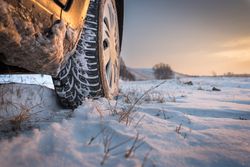Understanding the Differences Between Summer and All-Season Tires

To ensure maximum mileage and maneuverability, drivers must use tires that work well in the specific weather conditions their area faces. In Alaska, you may benefit from two sets of tires to handle its different seasons— summer tires and all-season tires. Below is a beginner’s guide to help you understand your options.
What Makes Summer Tires Different From All-Season Tires?
Summer Tires
Summer models are also known as performance tires. Thanks to their shallow grooves, they offer excellent traction during the warmer months and in hot climates. These types of tires ensure the majority of the rubber makes contact with the pavement to keep the car on the road.
These tires are made up of rubber and fillers that increase their stickiness to maintain their shape when pressing against hot pavement. Summer tires perform the best in temperatures above 44 degrees Fahrenheit, otherwise, they may become hard and inflexible.
Summer tires are not made for winter traction because they don’t hold their shape in the cold. The rib, or center area of the tread, often has a solid surface, providing a channel for rainwater dispersal. This feature is dangerous during icy or snowy conditions because it limits traction. Consider all-season varieties during winter months to improve safety, mileage, and control.
All-Season Tires
 All-season tires offer valuable traction for a variety of conditions. They feature symmetrical tread patterns with many voids to channel water and snow away from the vehicle while promoting grip on icy surfaces. Precipitation will disperse under the weight of the car and move into the tire’s grooves, which prevents hydroplaning.
All-season tires offer valuable traction for a variety of conditions. They feature symmetrical tread patterns with many voids to channel water and snow away from the vehicle while promoting grip on icy surfaces. Precipitation will disperse under the weight of the car and move into the tire’s grooves, which prevents hydroplaning.
These tires are an excellent value for use all-year-round but lack performance in very snowy or slick conditions. Individuals in colder climates may benefit from a true winter tire variety if they are frequently driving on sleet, ice, or deep snow.
Winter Tires
These tires are often a more expensive option due to performance enhancements specific to temperatures under freezing. Winter tires are made of softer rubber and include siping. This combination allows the tread to spread and grip the road at the point of contact. To increase safety and handling further winter tires have enough tread depth to allow “studding”. Hundreds of small steel studs are embedded in the tread to increase handling. However, do not run studs in summer months, it will wear the studs, roads, and reduce control.
If you’re looking for new tires or other quality auto parts, contact the professionals at Northwest Auto Parts in Anchorage, AK, to learn about their inventory. The area specialists offer excellent quality parts and tires for affordable prices. Call the Camelot Drive location at (800) 770-6531 or visit the website for information on their 70-year history of serving customers throughout Alaska.
About the Business
Have a question? Ask the experts!
Send your question

